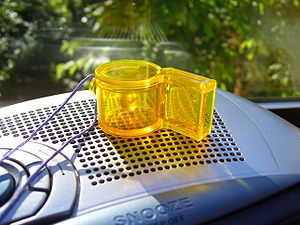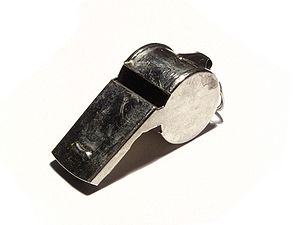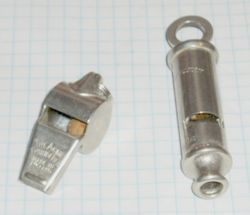AY Honors/Whistles/Answer Key
A simple whistle is a woodwind instrument which produces sound from a stream of forced air.
Many types exist, from small police and sports whistles (also called pea whistles), to much larger train whistles, which are steam whistles specifically designed for use on locomotives and ships. Although whistles have a musical characteristic (for example train whistles sound a minor-seventh musical chord) whistles are not usually considered "musical" in the sense of being able to play a chosen melody, but mainly the small whistles can also be used as a – very shrill and loud – noise and rhythm instrument. However, musical whistles exist, including any of several 2-octave musical instruments known as tin whistles (sometimes known as pennywhistles or low whistles), as well as the calliope (an array of separately actuable steam whistles), organ pipes and the recorder. Pea whistles are used in jazz and Latin music as a percussion instrument, and children often use them as a toy music instrument.
The whistle works by causing the smooth flow of air to be split by a narrow blade, sometimes called a fipple, creating a turbulent vortex which causes the air to vibrate. By attaching a resonant chamber to the basic whistle, it may be tuned to a particular note and made louder. The length of the chamber typically defines the resonance frequency. A whistle may also contain a small light ball, usually called the pea, which rattles around inside, creating a chaotic vibrato effect that intensifies the sound. Japanese bird whistles use several small balls and are half filled with water in order to reproduce the sound of a bird song.
A steam whistle works the same way, but using steam as a source of pressure: such whistles can produce extremely high sound intensities.
Sometimes, unintentional whistles can be set up. A common one is the opened sunroof of a car: air passing over the top of the vehicle can, at certain speeds, strike the back edge of the sunroof, creating a very low frequency whistle which is resonated by the closed interior of the car. Since the sound frequency is infrasonic, around 4 Hz, the effect is very uncomfortable for occupants, who feel the vibration rather than hear it. Such low frequencies can induce nausea, headache, disorientation and dizziness. The effect can be prevented by opening a side window a few inches. Subsonic whistles have also been developed for use as weapons, or to deliberately create a sense of uneasiness in an enemy.Template:Fact
History
The whistle has its roots dating back to ancient China. Chinese night watchmen used to blow into the tops of acorns in order to alert the towns of invading Mongolians.
In ancient Egypt two blades of the papyrus plant along the Nile river were held together in between the palms. By blowing into the palms the papyrus leaves would make a loud vibrant sound.
In 1868 Joseph Hudson (inventor) of Birmingham, England, made the first whistle ever to be used by a football referee. New Zealand referee William Atack was the world's first to use a whistle to stop a game of sport in 1884. It was used for the first time (allegedly) at a game held at Nottingham Forest, prior to this referees used handkerchiefs to attract players attention.
By 1884, Joseph Hudson had perfected his whistles and he released the world's most successful whistle to date, the "Acme Thunderer" (the first ever pea whistle). The whistle has been used as an alarm or attention-getting instrument by all manner of industries, sports and revellers. It continues to sell in great quantities throughout the world.
Police whistles
Hudson later made the first police whistle for the Metropolitan police force. Prior to this, police used hand rattles, with whistles only being used as musical instruments or toys. Rattles and whistles were used to call for back-up, in areas where neighbourhood beats overlapped.
Police whistles fell largely into disuse in 1959, when early hand-held radios were brought into service. With the rise of the motor car, the whistle was no longer usefully audible in urban areas. The whistle is still used by some police forces today, or are given to senior officers as engraved ceremonial items.
Industrial whistles
Industrial whistles are used for signalling and timekeeping both on railroad and ships, and in factories. jm vc knjnv jvbjbnnm vxcnnn cxzbbczbhncx bb cz b bh nhnhb chbvzcbhxkbjnvc kjnjncxhhvcxjxbbbbbbbbbbbbbbbbbbbbbbbbbbbbbbbbbbbbbbbbbbbbbbbbbbbbbbbbbbbbbbbbbbbbbbbbbbbbbbbbbbbbbbbbbbbbbbbbbbbbbbbbbbbbbbbbbbbb Regulations for Preventing Collisions at Sea#Part D - Sound and light signals|safety on the seas]]. Modern ship's whistles can be electrically driven or steam driven. The RMS Queen Mary was originally equipped with three electric Tyfon whistles in 1932. They could be heard at least ten miles away and were tuned to 55 Hz, a low bass A note that was chosen for maximum passenger comfort despite the high sound pressure level.<ref>[http://www.sterling.rmplc.co.uk/visions/funnel2.jpg The Voice of the Queen



